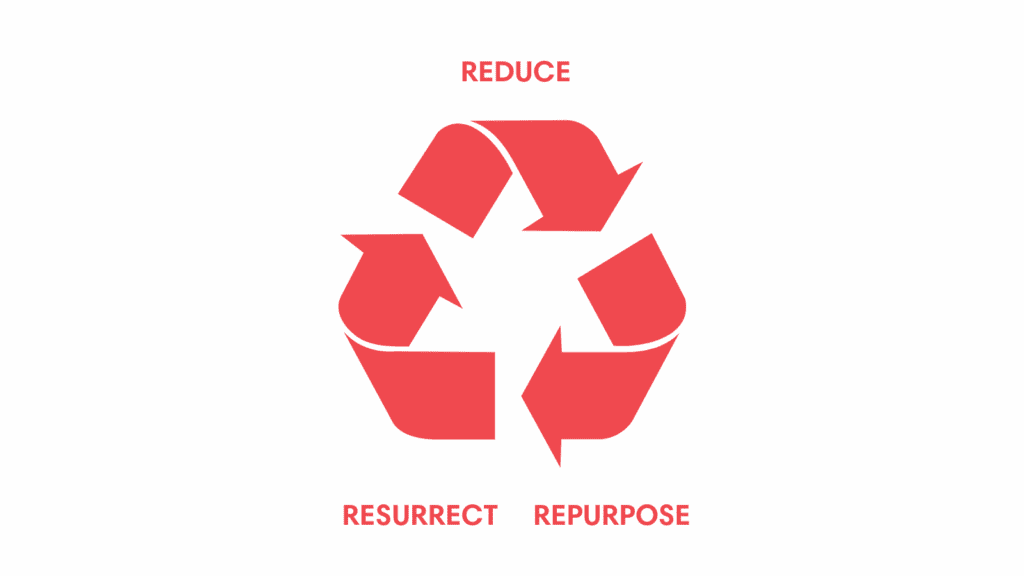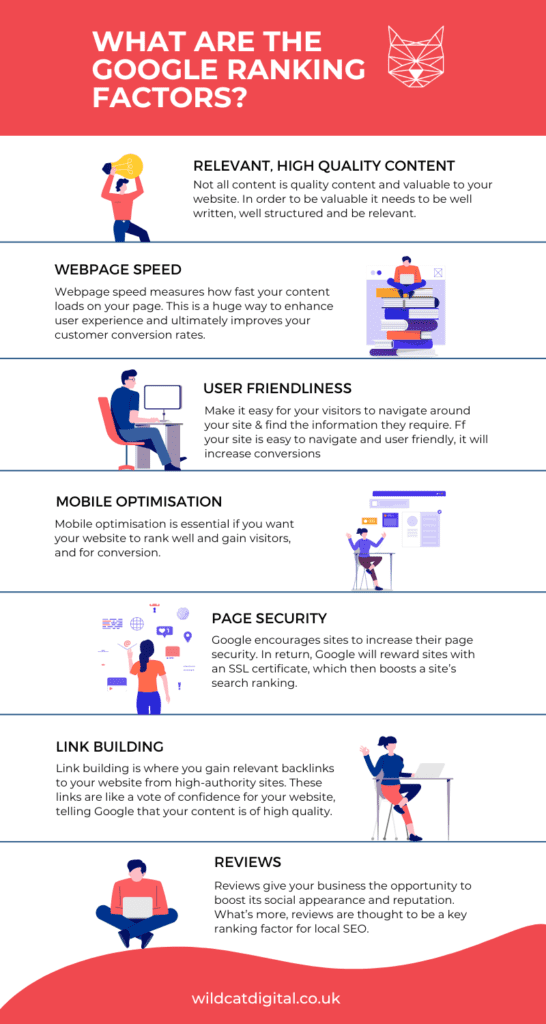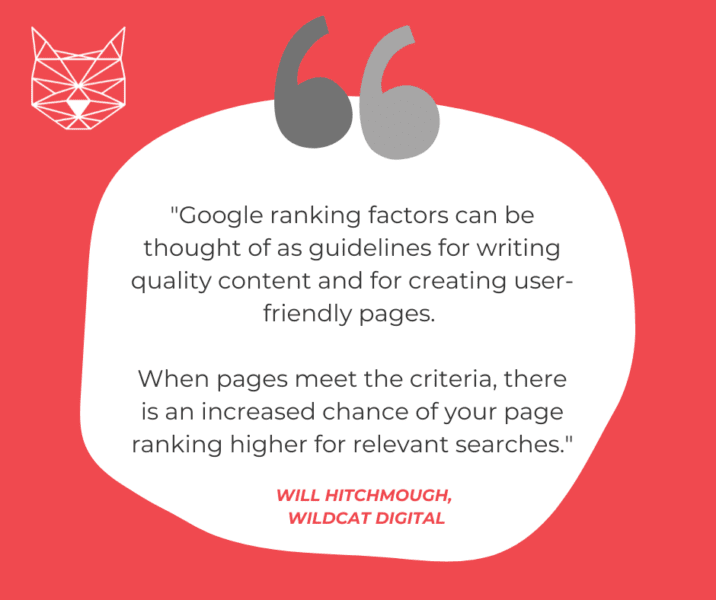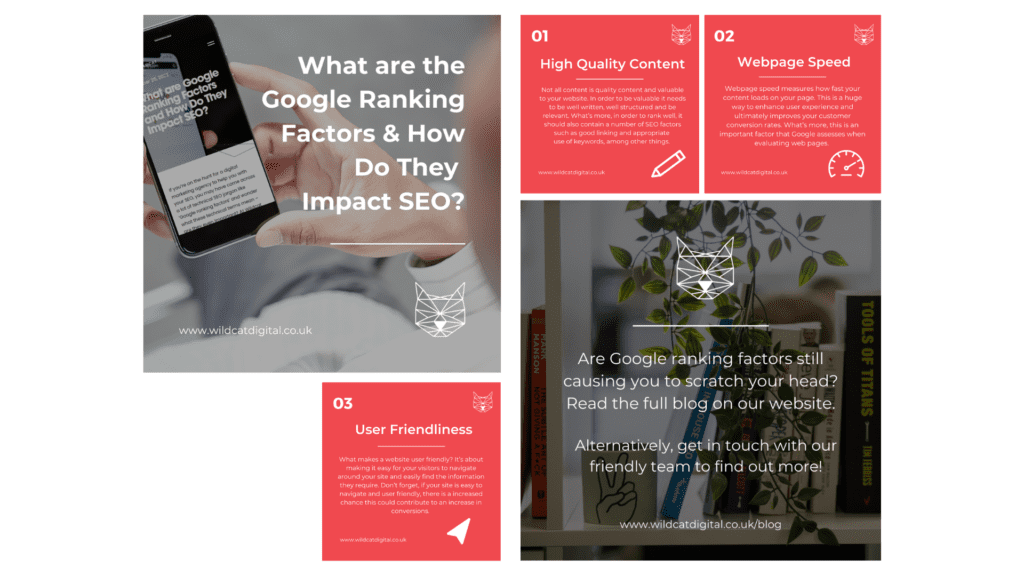Over 50% of marketers said that creating quality content was one of their biggest challenges in recent years, yet many don’t make the most of the content that already exists!
In this article, our content experts share the most effective ways to repurpose your blog & video content to improve reach online and better utilise your marketing budget. We’ll also discuss how this fits with the 3 Rs of content marketing.
What is repurposing content and how do you do it? Repurposing content means taking existing content, such as an article, and altering it to serve a different purpose. For example, turning blog content into an infographic, social media post, e-book, or gated content. You can also repurpose video content by turning it into a TikTok, or Instagram Reel, or by adding it to your website.
Read on to find out about the 3 Rs of content marketing. We’ll deep-dive into the third ‘R’ – repurposing content – and show you how to do so for blog and video content.
Let’s start with the basics. The 3 Rs of content marketing are; Reduce, Resurrect, and Repurpose. The purpose of the 3 Rs is to help marketers focus on quality over quantity in order to increase ROI from their content marketing efforts.

This step includes reducing or completely eliminating all of the content that does not align with your brand and wider business objectives. Utilise Google Analytics or Google Search Console to review blogs, landing pages, or other pieces of content that don’t deliver value. Removing this content will free up the crawl budget, helping Google index more of your important pages.
Once you have reviewed your underperforming content, it’s time to breathe new life into it. You may choose to add testimonials, videos, add internal links, optimise for keywords, or update the key headings. The actions you take will vary page-to-page. Don’t forget to optimise & update existing blog content for SEO.
To maximise the performance of your refreshed content, you need to get eyes on it – this is where content recycling happens. Transform your content into another format, such as a video, infographic, or whitepaper, and share it across your marketing platforms.
Content repurposing, sometimes called content recycling, is when you reuse all or parts of existing content (including a blog, video, etc) to transform it into a new format. This could include turning a blog post into a Twitter thread or turning a webinar into short social media posts.
Many people often get confused by repurposing content and think that it is something that it isn’t. Repurposing content is often confused with:
If you want some creative ways to repurpose your content, keep on reading!
There are many reasons why repurposing content should form part of your marketing strategy:
A lot of time goes into creating content, particularly long-form blogs, which often include extensive research, data, and quotes, to name a few! So why wouldn’t you want to save yourself time in future, all whilst doubling or even tripling the amount of content you can share across your marketing platforms?
When you maintain a consistent publishing frequency on your blog or social media profiles, it is likely that your content will get more shares. This not only improves your reach but will likely benefit your follower count and leads generated, helping you gain authority in your niche.
Catering to the needs of different audiences is an integral part of any marketing strategy. For example, some of your audience enjoy reading a 2,000-word blog, whilst others may prefer bite-sized pieces of information that they can digest on the go. Repurposing your content helps you to connect with a range of audience segments without spreading yourself thin.
By maximising the lifespan of one piece of content, you’ll spend less time creating new content (which is often expensive, if not time-consuming!). As a marketer, you may have also heard of the ‘7 touchpoints’; it takes 7 interactions with your brand before someone will convert. Therefore, the more quality content you put out across your marketing channels, the more likely you are to generate new leads for your business.
Fresh, unique content takes time. Yet some marketers publish one blog and leave it there – and yet wonder why they’re not seeing much traffic! Repurposing your content across other marketing channels is an excellent way to boost your reach whilst minimising time spent on content creation.
There are so many ways to get more eyes on your original content and scale your reach. We’ve outlined some of the most effective ways below:
Blog content offers so much value, and not just for SEO. Of course, you shouldn’t recycle the same 5 posts all the time, but instead, choose one or two that you think resonates best with your audience. Here’s how you can repurpose your blog content for other marketing channels…
Infographics work really well on a number of social media platforms, in particular, Pinterest and Instagram stories. To make your infographic, pull the most important points or pieces of data from your blog, and add them to a template with engaging graphics and visuals.
Graphic design software, such as Canva, has a range of helpful & free infographic templates to help you get started.

Podcasts are a great way to connect with your audience on a personal level, which is particularly important for B2B businesses. Start by looking at your most successful blogs in terms of views and dwell time to find the topics your audience is most interested in.
When it comes to recording, don’t just read the post aloud. Instead, cover the key points and expand on what you wrote. You could invite a guest to discuss the subject with you, or even ask your audience to send in their questions.
Once live, don’t forget to include your podcast episode in the original blog post to encourage new listeners!
If you’ve written multiple blogs around the same topic, you could condense that information into a digital asset, usually in the form of an ‘ultimate’ guide or an eBook. Use graphic design software to create an easy-to-read layout with the addition of graphics or images. Export it to a PDF and add it to your website.
If you wanted to, you could charge for users to access this gated content, or use a lead generation form.
If you’d like help creating your own ‘ultimate’ guide or blogs for SEO, why not get in touch with our content experts? We’ll work with you to improve the visibility of your brand, helping you stand out from the competition.
If you have a set of original data included in your blog, why not deep dive into how you did it? A research report will follow the same principles of an eBook, but instead, you’ll add information on:
Share your research report on social media, on your website, use it as part of an online course, or share it with publications in your niche.
If you’ve interviewed or referenced an industry expert or a celebrity in your blog post, why not repurpose some of the best bits? Simply extract a quote that you think will resonate with your audience and use it on an eye-catching graphic with your brand colours and logo.
This type of post works well on pretty much all social media platforms. What’s more, your special guest may share or repost your quote, therefore increasing your reach! Don’t forget to mention who said the quote and encourage readers to read your blog for more information.

If a blog post is performing particularly well in terms of traffic, but not so much in terms of sales & ROI, why not try gating some of the content? Gated content requires a user to pay or fill in contact details before viewing the blog post.
This is an effective way to generate inbound leads or to build up your email marketing list. Once a user has completed their contact information, you can nurture prospects with other marketing efforts, or reach out directly to connect.
For those of you who have created ‘how-to’ blogs around a content ‘pillar’ (i.e. created numerous pieces of content around the same core topic), why not consider educating your audience by creating an online course?
An online course shares the same principles as gated content. You’ll simply combine all of the content you have around one subject (restructuring or adding content as needed), and publish it on an online course platform, such as Udemy or Teachable. Users will have to sign up to access the content, helping you generate new leads and revenue.
If you have the time, consider recording videos to add to your course material. Not only will this make it more engaging for your audience, but these videos are great for repurposing across social media.
Think about your marketing objectives when pricing your course. Is this a new product? Do you want to increase revenue? Or do you simply want to generate new leads? The value that your content provides should also influence the price of your online course.
If you’re a subject matter expert, consider finding users on forums asking questions about what you do best. Answer their question clearly and concisely, taking snippets from your existing content. If it feels natural, add a link to your blog.
Don’t overdo this, however, as being overly promotional may get you banned from forums and threads.
To find forums in your niche, similarly to how you’d find guest blogging opportunities, simply search for ‘keyword’ & ‘forum’.
Over 60 million people visit websites like SlideShare monthly, making it a useful resource for people looking to share their expertise. Simply take the key parts of your blog and reformat them into a simple presentation before uploading them to a slide-sharing website.
SlideShare, SlideWorld and Scribd are all fantastic platforms, each allowing you to share your side decks for a small fee, or even for free!
According to Hootsuite in 2022, over 51% of marketers are struggling to consistently produce creative content for social media platforms. But sometimes you don’t have to reinvent the wheel for great social content. Carousels are super engaging on Instagram, so create one highlighting the main points of your blog content.

Tweets limit you to only 280 characters, which certainly isn’t long enough to inform or engage users. Instead, try turning the main headings and subheadings of your latest blog post into a Twitter thread. A thread connects multiple Tweets together, making it a great option for sharing snippets of long-form content. Complete your Twitter thread with exciting visuals to help further increase engagement.
Join LinkedIn & Facebook relevant to your niche and share your expertise. If anyone has a question or query that relates to your blog, kindly share an answer to their question with a link to your blog. As with posting on forums, don’t aggressively promote your content on groups, only do so when genuinely helpful.
Video content is often the most expensive and time-consuming to create but it is one of the most effective mediums. Here’s how you can utilise your existing videos:
Did you know that using video on a landing page can almost double your conversions? You heard that right!
Whether it be product demonstrations, video testimonials, or company showreels, putting your video on a landing page is a great way to boost audience engagement and increase dwell time. Keep your video short and to the point on a landing page, and keep in mind that you may need to resize it for mobile users.
Teasers are a great way to generate interest before or during a launch. Simply post the first 10 seconds of the most exciting snippet of your video and post it on Instagram, Facebook, or a similar platform. In the caption, encourage your social media followers to head to your website or YouTube channel to watch the full video.
Short videos are everywhere in 2023. Whether it be TikTok, Instagram, or even YouTube, scrollable videos are a great way to engage your audience with content that already exists.
If you have a video recording of your podcast, don’t hesitate to post clips and snippets on social media. A product review? Share that as well. The options are endless but think about the content that would resonate best with your audience. Don’t forget to resize each of these videos for mobile.
Text transcripts are perfect for boosting the accessibility of your content with assistive technology, but they can also help boost your Google & YouTube SEO efforts. You can upload the transcript to your blog, or use it as a caption under a website video.
Text transcripts are generally recommended for:
On-demand webinars are a great way to capture leads and inform your audience, without the complications of a live webinar! To create your webinar, first, decide on your topic – what might your audience want? What topic adds the most value?
Once your topic has been decided, chop and change your existing video content on the same topic until you have a 30-60 minute video. Add it to a landing page on your site and promote it via email and social media marketing.
If you’ve ever held a live webinar, find the recording and put it on your website. If your goal is to generate more leads, add the video as gated content.
GIFs make for amusing and engaging social media content, not to mention they are so easy to make. You could make a GIF previewing the construction of your product, small animations, or go for something funny like video bloopers.
Using a tool like Adobe GIF Converter allows you to simply upload any video from your computer, resize it for numerous social media platforms, and download your already-shareable gif.
Video rich snippets come up on Google’s search results and are pulled from the Structured Data (or Schema Markup) added to your site. If you have added a video to a landing page, video snippet tags are a great way to take up more real estate on the SERPs, in turn, boosting the clicks through to your website
Video rich snippets are best for recipe videos, event videos, or interviews. To add your own, use Google’s Structured Data Markup Helper to create your Structured Data, and add it to your webpage using Google Tag Manager.
Technical SEO can be complicated to get your head around; if you are looking for SEO help, or simply want strategic advice, don’t hesitate to contact our team. Alternatively, find out more about technical SEO in one of our recent blogs.
In this blog, our expert content writers have taken you through their top tips for repurposing content, which should help you save time whilst maximising your marketing budget.
If you’re still stuck, or you don’t have time to create your own content for SEO, why not work with our experts? Contact our team for a free, no-obligation consultation and marketing proposal.
No, you shouldn’t repurpose someone else’s content unless you have their written permission. If you don’t have permission, you may face prosecution for copyright infringement or a penalty from Google for ‘duplicate content’. If you use someone else’s work, you should always credit the original creator.
If you’d like to find out more about duplicate content and its effect on SEO, read one of our recent blogs.
If you have repurposed or updated your content in some way, it can be republished straight away – just make sure not to bombard your audience with the same piece of information over and over again.
If you are syndicating your content, you should wait at least 1-2 weeks before republishing on another site.
There are several ways to promote your content, but how you choose to do so should depend on your target audience and marketing objectives. You could:

Founder
Our founder, Will Hitchmough, worked at a number of high profile Sheffield Digital Agencies before founding Wildcat Digital in 2018. He brings an extensive knowledge of all things related to SEO, PPC and Paid Social, as well as an expert knowledge of digital strategy.
Digital Marketing can be a minefield for many businesses, with many agencies ready to take your money without knowing how to deliver results. I founded Wildcat Digital to deliver digital success to businesses with smaller budgets in a transparent way.

Head of Growth
Rich joined us in May 2024 to head up our growth team. With years of experience helping other agencies to grow, Rich joins us at an exciting time as Wildcat is working on a five-year plan to become one of the biggest agencies in the UK.
Outside of work, Rich is a father to three children, which keeps him very busy! He’s also recently started running again to keep fit and loves a bit of DIY.

Head of Digital
Sarah joined Wildcat in January 2025, bringing over seven years of SEO expertise to the team. With a background in Fashion Communication and Promotion, she has worked both in-house and at agencies, covering a range of digital marketing specialisms before focusing on SEO.
Passionate about all things search, Sarah thrives on helping brands grow their online presence.
Outside of work, she enjoys walking her dog, running, and shopping for vintage clothing.

Office Manager
Amelia joined Wildcat Digital in January 2025, bringing extensive experience in HR, Health & Safety, Facilities Management and IT Support. Previously an Operations Manager at The University of Sheffield, she has a strong background in creating efficient and well-organized work environments.
Specialising in HR, Health & Safety, and Facilities Management, Amelia ensures the Wildcat Digital team has the resources and support needed to thrive. Whether managing office operations, maintaining compliance, or fostering a positive workplace culture, she keeps everything running smoothly.
Outside of work, Amelia loves trying new things, traveling, camping, and walking. She also enjoys socialising and exploring new places with friends and family. Her adventurous spirit and proactive approach make her a valued member of the team.

Client Success Coordinator
Siena joined us in 2023 with a background in sales and digital marketing. She leads on client relationships across the company, ensuring that our customers are happy throughout their journey with us, from their initial consultation through to onboarding and beyond.
Outside of work, Siena enjoys travelling and getting stuck into the local culture. She likes to make the most of her experiences and particularly enjoys watching sunrises and sunsets from beautiful locations around the world.

SEO Account Director
Paul has a strong background in SEO, having previously founded and ran a successful eCommerce business, as well as running a personal blog that achieves an average of 17K users per month. Paul’s knowledge of SEO is extensive, with a strong emphasis on client handling and technical SEO.
Outside of work, Paul enjoys spending time with his family and staying active with weight lifting and combat sports.

Team Lead & Technical SEO Account Manager
With a degree in Computer Science and SEO experience dating back to 2017, Dariusz has a wide range of SEO skills and knowledge. His specialist knowledge of Technical SEO has firmly landed him the title of Wildcat’s Technical Wizard, and he has recently taken on the responsibility of Team Leader for the Panthers Team.
In his spare time, Dariusz loves hiking, experimenting and trying new coffees and loves learning new things. He is currently learning more about CRO and AI and how this could benefit our clients.

Team Lead & Senior SEO Account Manager
With a background in sales, Molly is a natural Account Manager, brilliantly handling any issues that come her way. Having joined us as a Digital Marketing Executive, and working part-time through her final year of University, Molly is a shining example of how hard work pays off. She is now an SEO Account Manager with a particular interest in Content and Client Management.
In her spare time, Molly loves to get out in nature, hiking and exploring the Peak District. She also loves cooking and likes to unwind with a bit of yoga.

PPC Team Leader
Libby joined Wildcat in 2021 as our first PPC hire. With a degree in Digital Media Production, a Master’s in Digital Media Management and previous experience in Social Media Management, Libby hit the ground running and has since climbed the ranks to Senior PPC Account Manager and has a particular interest in the eCommerce sector.
Outside of work, Libby likes gaming, and cooking and likes to keep active by lifting weights.

Senior SEO Account Manager
With a degree in Film and TV production, and a varied career history, Jamie made the move to marketing with a Masters degree in Digital Media Management. He has since worked in SEO at Agencies across Sheffield, before joining Wildcat and working his way up to SEO Account Manager. Jamie has a particular interest in backlinks and Digital PR and has recently gained a client a valuable backlink from Forbes!
In his spare time, Jamie is an avid foodie and loves trying new restaurants and cuisines. He also loves to travel and spent a year travelling to Australia after university.

SEO Account Manager
Jasmine joined Wildcat in 2022 with a strong background in SEO and Account Management. At the time, she was finishing up a Level 4 Apprenticeship in Digital Marketing from the Chartered Institute of Marketing, and has since worked her way up to SEO Account Manager. Jasmine excels at content writing and promotion, and particularly enjoys finding creative ways to join the dots on multi-channel campaigns.
In her spare time, Jasmine volunteers at a charity, helping combat loneliness & social isolation experienced by older neighbours. Outside of Wildcat, she owns a catering company, Savery Grazing, creating delicious grazing tables & platters for a range of events. She also loves skiing and exploring the Peak District.

SEO Account Manager
Thea has a wealth of experience in SEO, having previously worked for other Digital Marketing Agencies in Sheffield. She has a particular interest and skills in Technical SEO, but is more than willing to get stuck in and give anything a go.
Outside of work, Thea spends most of her time with her children, but also loves reading, photography and gardening.

PPC Account Manager
Masilda joined the Wildcat team in October 2024 with over seven years of experience in digital marketing. She specialises in Google Ads, but is also certified in Google Analytics, YouTube Ads, Google Ads for Ecommerce and Apple Search Ads. She has extensive expertise in performance marketing, display advertising, online lead generation and market planning.
In her free time, Masilda likes staying active, cooking, trying new restaurants and exploring new places.

Senior SEO Executive
After spending ten years managing businesses, restaurants, cafes and event spaces across Sheffield, Jon decided to change careers and joined Wildcat as an SEO Executive in 2022. He especially enjoys the client management side of the job, helping them to understand digital marketing and ways in which they can build their business’s presence online.
Outside of work, Jon likes to keep fit with running, badminton and football, and also loves music.

Senior SEO Executive
Andy joined Wildcat in 2023 after starting his digital marketing career in-house for a local Sheffield company. Since joining, he has developed a strong interest in Technical SEO and has strong skills in Account Management.
Outside of work, Andy loves music and plays in a couple of bands. He also enjoys rock climbing, cycling, photography and good food.

Senior SEO Executive
Kezia joined us in July 2024 after completing a CIM Certificate in Digital Marketing and gaining experience in Content SEO at another Sheffield agency.
In her spare time, Kezia loves to get outdoors, bouldering, hiking and travelling.

Senior PPC Executive
Alex joined Wildcat Digital in December 2024 as a Senior PPC Executive, bringing a strong background in Paid Media, Paid Social, and Programmatic advertising. With a degree in Business & Marketing and Google Ads certifications, she has the expertise to craft high-performing campaigns that drive results.
Before joining Wildcat Digital, Alex worked at two leading agencies in Leeds, honing her skills across various digital advertising platforms. Her analytical mindset and strategic approach help businesses maximize their online presence and advertising budgets.
Outside of work, Alex enjoys spending time with her dog, Lola, and going on walks with her dog walking group. She’s also a keen footballer and loves playing five-a-side whenever she gets the chance. Her enthusiasm and team spirit make him a great addition to the Wildcat Digital team.

SEO Executive
Amy joined Wildcat in 2024 with a background in journalism, having worked as a News Editor and Editor-in-Chief at The Sheffield Tab. She is naturally interested in Content SEO and research, so will no doubt prove to be a content power-house.
In her spare time, Amy loves watching crime shows, listening to music and hanging out with her dog, Eddie!

June 30, 2025
Welcome to June’s digital marketing news roundup. There’s been major changes in both PPC and SEO, especially regarding AI. We’ll…
May 30, 2025
If you’ve ever tried searching for a local business or service, the chances are you’ve come across a Google map…

May 20, 2025
Welcome to this month’s digital marketing news roundup! As ever the digital landscape continues to transform at lightning speed, so…